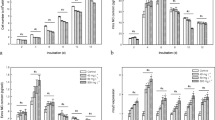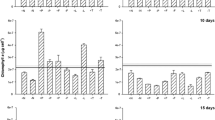Abstract
Microcystis is a well-known toxic cyanobacterium in eutrophic environments, and an increasing number of Microcystis blooms have emerged in salty reservoirs and coastal rivers. This study observed that many Microcystis were identified in a coastal river in June 2020. The relative abundance of Microcystis decreased from 81.2 to 10.2% in the sampling sites from a salinity of 0 (Sal. 0) to a salinity of 12 (Sal. 12). Hepatotoxic microcystins (MCs) were identified in the coastal river and its estuary. Of the samples, those with a salinity of 5 (Sal. 5) had the highest concentration of MCs at 7.81 ± 0.67 μg L−1. In a saline water simulation experiment, the results showed that salt inhibited Microcystis (M.) aeruginosa growth, enhanced the activity levels of superoxide dismutase (SOD) and catalase (CAT) and stimulated microcystin production. Transcription analysis showed that the expression levels of the psaB and rbcL genes controlling photosymbiotic processes were downregulated, and capD and csaBgene-related polysaccharide productions were upregulated by salt incubation. Notably, metabolism analysis showed that the total polysaccharides, proteins and small molecular matter, such as sucrose, methionine and N-acetyl-D-glucosamine, in the Microcystis cells increased substantially to resist the extracellular hyperosmotic pressure caused by the high salinity levels in culture. These findings indicate that increased salt in a natural aquatic body shifts the phytoplankton community by influencing the physiological metabolism of cyanobacteria and poses a high risk of microcystin exposure during cyanobacterial blooms in coastal rivers.






Similar content being viewed by others
Data availability
The datasets used during the current study are available from the corresponding author on reasonable request. Original sequences of the bacterial community associated with Microcystis in the NCBI database: SRA accession: PRJNA508584, Temporary Submission-ID: SUB4880834.
References
Adenan NS, Fatimah MY, Mohamed S (2013) Effect of salinity and temperature on the growth of diatoms and green algae. J Fish Aquat Sci 8:397–404. https://doi.org/10.3923/jfas.2013.397.404
Ardón M, Morse JL, Colman BP, Bernhardt ES (2013)Drought-induced saltwater incursion leads to increased wetland nitrogen export. Glob Chang Biol 19:2976–2985. https://doi.org/10.1111/gcb.12287
Cai Y, Weng K, Guo Y, Peng J, Zhu ZJ (2015) An integrated targeted metabolomic platform for high-throughput metabolite profiling and automated data processing. Metabolomics 11:1575–1586. https://doi.org/10.1007/s11306-015-0809-4
Cañedo-Argüelles M, Hawkins CP, Kefford BJ, Schäfer RB, Dyack BJ, Brucet S, Buchwalter D, Dunlop J, Frör O, Lazorchak J, Coring E, Fernandez HR, Goodfellow W, González Achem AL, Hatfield-Dodds S, Karimov BK, Mensah P, Olson JR, Piscart C, Prat N, Ponsá S, Schulz CJ, Timpano AJ (2016) Saving freshwater from salts. Science 351:914–916. https://doi.org/10.1126/science.aad3488
Chen L, Mao FJ, Kirumba GC, Jiang C, Manefield M, He YL (2015) Changes in metabolites, antioxidant system, and gene expression in Microcystis aeruginosa under sodium chloride stress. Ecotox Environ Safe 122:126–135. https://doi.org/10.1016/j.ecoenv.2015.07.011
Desplats P, Folco E, Salerno GL (2005) Sucrose may play an additional role to that of an osmolyte in Synechocystis sp. PCC 6803 salt-shocked cells. Plant Physiol Biochem 43:133–138. https://doi.org/10.1016/j.plaphy.2005.01.008
Engene N, Tronholm A, Paul VJ (2018) Uncovering cryptic diversity of Lyngbya: the new tropical marine cyanobacterial genus Dapis (Oscillatoriales). J Phycol 54:435–446. https://doi.org/10.1111/jpy.12752
Engström-Öst J, Repka S, Mikkonen M (2011) Interactions between plankton and cyanobacterium Anabaena with focus on salinity, growth and toxin production. Harmful Algae 10:530–535. https://doi.org/10.1016/j.hal.2011.04.002
Gan N, Xiao Y, Zhu L, Wu Z, Liu J, Hu C, Song L (2012) The role of microcystins in maintaining colonies of bloom-formingMicrocystis spp. Environ Microbiol 14:730–742. https://doi.org/10.1111/j.1462-2920.2011.02624.x
Georges d AM, Roux P, Caruana A, Réveillon D, Briand E, Hervé F, Savar V, Bormans M, Amzil Z (2019) Physiological and metabolic responses of freshwater and brackish-water strains of Microcystis aeruginosa acclimated to a salinity gradient: insight into salt tolerance. Appl Environ Microbiol 85:e01614–e01619. https://doi.org/10.1128/AEM.01614-19
Hagemann M (2011) Molecular biology of cyanobacterial salt acclimation. FEMS Microbiol Rev 35:87–123. https://doi.org/10.1111/j.1574-6976.2010.00234.x
Havens KE (2008) Cyanobacteria blooms: effects on aquatic ecosystems. In: Hudnell H. (eds) Cyanobacterial harmful algal blooms: state of the science and research needs, Adv Exp Med Biol, pp 733-774.
He Y, Ma Y, Du Y, Shen SD (2018) Differential gene expression for carotenoid biosynthesis in a green alga Ulva prolifera based on transcriptome analysis. BMC Genomics 19:916. https://doi.org/10.1186/s12864-018-5337-y
Kim YK, Yoo WI, Lee SH, Lee MY (2005) Proteomic analysis of cadmium-induced protein profile alterations from marine alga Nannochloropsis oculata. Ecotoxicology 14:89–596. https://doi.org/10.1007/s10646-005-0009-5
Kaushal SS, Likens GE, Pace ML, Utz RM, Haq S, Gorman J, Grese M (2018) Freshwater salinization syndrome on a continental scale. Proc Natl Acad Sci U S A 115:574–583. https://doi.org/10.1073/pnas.1711234115
Liska AJ, Shevchenko A, Pick U, Katz A (2004) Enhanced photosynthesis and redox energy production contribute to salinity tolerance in Dunaliella as revealed by homology-based proteomics. Plant Physiol 136:2806–2817. https://doi.org/10.1104/pp.104.039438
Livak KJ, Schmittgen TD (2001) Analysis of relative gene expression data using real-time quantitative PCR and the 2(-Delta Delta C(T)) method. Methods 25:402–408. https://doi.org/10.1006/meth.2001.1262
Marampouti C, Buma AGJ, de Boer MK (2020) Mediterranean alien harmful algal blooms: origins and impacts. Environ Sci Pollut Res 28:3837–3851. https://doi.org/10.1007/s11356-020-10383-1
Martinez d EG, Segura AM, Nogueira L, Alcántara I, Piccini C (2017) Dynamics of toxic genotypes of Microcystis aeruginosa complex (MAC) through a wide freshwater to marine environmental gradient. Harmful Algae 62:73–83. https://doi.org/10.1016/j.hal.2016.11.012
Melero-Jiménez IJ, Martín-Clemente E, García-Sánchez MJ, Bañares-España E, Flores-Moya A (2020) The limit of resistance to salinity in the freshwater cyanobacterium Microcystis aeruginosa is modulated by the rate of salinity increase. Ecol Evol 10:5045– 5055. 10:5045–5055. https://doi.org/10.1002/ece3.6257
Metcalf JS, Banack SA, Wessel RA, Lester M, Pim JG, Cassani JR, Cox PA (2021) Toxin analysis of freshwater cyanobacterial and marine harmful algal blooms on the west coast of Florida and implications for estuarine environments. Neurotox Res 39:27–35. https://doi.org/10.1007/s12640-020-00248-3
Mulo P, Sakurai I, Aro EM (2012) Strategies for psbA gene expression in cyanobacteria, green algae and higher plants: from transcription to PSII repair. Biochimica et Biophysica Acta (BBA)-Bioenergetics 1817:247–257. https://doi.org/10.1016/j.bbabio.2011.04.011
Ni L, Jie XT, Wang PF, Li SY, Wang G, Li YP, Li Y, Acharya K (2015) Effect of linoleic acid sustained-release microspheres on Microcystis aeruginosa antioxidant enzymes activity and microcystins production and release. Chemosphere 121:110–116. https://doi.org/10.1016/j.chemosphere.2014.11.056
Niu Y, Shen H, Chen J, Xie P, Yang X, Tao M, Ma ZM, Qi M (2011) Phytoplankton community succession shaping bacterioplankton community composition in Lake Taihu, China. Water Res 45:4169–4182. https://doi.org/10.1016/j.watres.2011.05.022
O’neil JM, Davis TW, Burford MA, Gobler CJ (2012) The rise of harmful cyanobacteria blooms: the potential roles of eutrophication and climate change. Harmful Algae 14:313–334. https://doi.org/10.1016/j.hal.2011.10.027
Oren A, Mana L (2002) Amino acid composition of bulk protein and salt relationships of selected enzymes of Salinibacter ruber, an extremely halophilic bacterium. Extremophiles 6:217–223. https://doi.org/10.1007/s007920100241
Otten TG, Paerl HW, Dreher TW, Kimmerer WJ, Parker AE (2017) The molecular ecology of Microcystis sp. blooms in the San Francisco Estuary. Environ Microbiol 19:3619–3637. https://doi.org/10.1111/1462-2920.13860
Pade N, Hagemann M (2015) Salt acclimation of cyanobacteria and their application in biotechnology. Life 5:25–49. https://doi.org/10.3390/life5010025
Pfaffl MW (2001) A new mathematical model for relative quantification in real-time RT-PCR. Nucleic Acids Res 29:e45. https://doi.org/10.1093/nar/29.9.e45
Preece EP, Hardy FJ, Moore BC, Bryan M (2017) A review of microcystin detections in estuarine and marine waters: environmental implications and human health risk. Harmful Algae 61:31–45. https://doi.org/10.1016/j.hal.2016.11.006
Ross C, Santiago-Vázquez L, Paul V (2006) Toxin release in response to oxidative stress and programmed cell death in the cyanobacterium Microcystis aeruginosa. Aquat Toxicol 78:66–73. https://doi.org/10.1016/j.aquatox.2006.02.007
Sangolkar LN, Maske SS, Chakrabarti T (2006) Methods for determining microcystins (peptide hepatotoxins) and microcystin-producing cyanobacteria. Water Res 40:3485–3496. https://doi.org/10.1016/j.watres.2006.08.010
Schaefer AM, Yrastorza L, Stockley N, Harvey K, Harris N, Grady R, Sullivan J, McFarland M, Reif JS (2020) Exposure to microcystin among coastal residents during a cyanobacteria bloom in Florida. Harmful Algae 92:101769. https://doi.org/10.1016/j.hal.2020.101769
Sellner KG, Lacouture BR, Parrish CR (1988) Effects of increasing salinity on a cyanobacteria bloom in the Potomac River estuary. J Plankton Res 10:49–61. https://doi.org/10.1093/plankt/10.1.49
Śliwińska-Wilczewska S, Cieszyńska A, Konik M, Maculewicz J, Latała A (2019) Environmental drivers of bloom-forming cyanobacteria in the Baltic Sea: effects of salinity, temperature, and irradiance. Estuar Coast Shelf Sci 219:139–150. https://doi.org/10.1016/j.ecss.2019.01.016
Tonk L, Bosch K, Visser PM, Huisman J (2007) Salt tolerance of the harmful cyanobacterium Microcystis aeruginosa. Aquat Microb Ecol 46:117–123. https://doi.org/10.3354/ame046117
Tzubari Y, Magnezi L, Be'er A, Berman-Frank I (2018) Iron and phosphorus deprivation induce sociality in the marine bloom-forming cyanobacterium Trichodesmium. The ISME journal 12:1682–1693. https://doi.org/10.1038/s41396-018-0073-5
Wichelen JV, Vanormelingen P, Codd GA, Vyverman W (2016) The common bloom-forming cyanobacterium Microcystis is prone to a wide array of microbial antagonists. Harmful Algae 55:97–111. https://doi.org/10.1016/j.hal.2016.02.009
Williams AA, Lauer NT, Hackney CT (2014) Soil phosphorus dynamics and saltwater intrusion in a Florida Estuary. Wetland 34:535–544. https://doi.org/10.1007/s13157-014-0520-7
Zavřel T, Očenášová P, Sinetova MA, Červený J (2018) Determination of storage (starch/glycogen) and total saccharides content in algae and cyanobacteria by a phenol-sulfuric acid method. Bio-protocol 8:e2966. https://doi.org/10.21769/BioProtoc.2966
Funding
This work was supported by the Science and Technology Plan of Yantai City (2018ZHGY080 and 2018ZHGY083), the Key Project of Shandong Provincial Natural Science Foundation (ZR2020KE048) and the Strategic Priority Research Program of the Chinese Academy of Sciences (XDA23050203).
Author information
Authors and Affiliations
Contributions
Wenjing Wang: conceptualisation, methodology, and writing—original draft preparation. Yanqing Sheng: writing—reviewing and editing. Ming Jiang: investigation and software.
Corresponding author
Ethics declarations
Ethics approval and consent to participate
Not applicable.
Consent for publication
Not applicable.
Statement of informed consent, human/animal rights, if any, for the work described
No conflicts, informed consent or human or animal rights are applicable.
Competing interests
The authors declare no competing interests.
Additional information
Responsible Editor: Philippe Garrigues
Publisher’s note
Springer Nature remains neutral with regard to jurisdictional claims in published maps and institutional affiliations.
Supplementary information
ESM 1
(DOCX 764 kb)
Rights and permissions
About this article
Cite this article
Wang, ., Sheng, Y. & Jiang, M. Physiological and metabolic responses of Microcystis aeruginosa to a salinity gradient. Environ Sci Pollut Res 29, 13226–13237 (2022). https://doi.org/10.1007/s11356-021-16590-8
Received:
Accepted:
Published:
Issue Date:
DOI: https://doi.org/10.1007/s11356-021-16590-8




